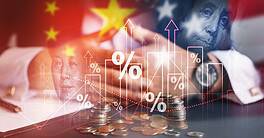Jacob Rothman, President and CEO at Shanghai-headquartered Velong enterprises, a cooking equipment manufacturer and exporter, navigates shifting tariff and trade policies.
Global Finance: Can your business in China remain viable with 30% US tariffs?
Jacob Rothman: I think now that there are some issues that are driving this, and they are challenging. A main issue is: Can I trust that figure? Our customers are looking at this and because retail product cycles work in the way that they do we’re quoting or have quoted to our customers for the next season.
GF: So that strengthens the strategy to look beyond manufacturing in China?
Rothman: The recent decisions by the Trump administration regarding tariffs on Chinese imports into the US haven’t changed our push to move manufacturing outside of China. Still, can we work with 30%? We had built up inventories that were substantial, of between $8 million to $10 million.
And we need money to build our factories overseas, which at our scale is of around $160 million in China combined with our Indian manufacturing partners now—we have two factories in India and one in Cambodia—we get to around $250 million. Based on those totals, $10 million is a lot for us and I need the money for cash flow, and for investing. And so the relief at the 30% tariff level came from being able to get our inventory moving, but our customers have to worry about their cash flow as well.
GF: What is the situation regarding freight and shipping?
Rothman: Some ports such as Qingdao and Yantian as well as Shanghai, and Ningbo were overwhelmed for a period of time but they’re not that way now. One factor is drastically increased shipping prices, almost Covid-era shipping prices. Ships that are carrying goods from China or Asia in general to the United States, have dropped in number drastically. Pricing for shipping might take 18 months to get back to where they were, and they were already high.
GF: How are your peers responding?
Rothman: They are saying let’s focus more on Europe, but we have way too much capacity for what are much smaller markets. And so, it’s got us all forced and pitted against each other to go after a smaller pie, and frankly we’re doing it because we have to.
GF: Is it very price sensitive?
Rothman: It’s price sensitive and even more so now because all of us are competing for those markets. Still, we were never just focused on the United States. Canada is a good market but small. And the population is a fraction of the population in the United States. Over the years, you’ve had super retailers like Walmart, Home Depot, and Lowe’s, which dominate the majority of the market and the same thing has happened in Europe with Carrefour or Tesco. And each of those markets operate differently in terms of product demand, plus you don’t have the same volumes that you get in the US. European regulations are another consideration.
GF: How important are exchange rates to your business?
Rothman: When I first got here 20 years ago, the renminbi to the dollar was 8.2 and now it’s 7.4—quite a devaluation—and that has affected us positively, but now the dollar is weaker and predicted this year to be perhaps 5% to 8% off. That makes Chinese exports more expensive, and we have the tariffs and shipping rates which are hurting us. All these things together add up. So, I think when you saw that easing off of tensions between President Trump and President XI there was initial elation, but when you add up all these factors it’s still tough.
GF: There’s a lot of talk of supply chain recalibration within APAC. Is that materializing?
Rothman: During President Trump’s first term through Biden’s term the majority went to Vietnam, and you have the Japanese factories, the Korean factories, and the Vietnamese factories. Now I would say China has taken the lead.
The issue is that people see this trade spat now as an American issue but it’s a China issue as well. And I think people want to see a more balanced supply chain and the people who are going to work through this will survive, commerce will be balanced, and maybe that will be better for the world. But it’s certainly painful now.




